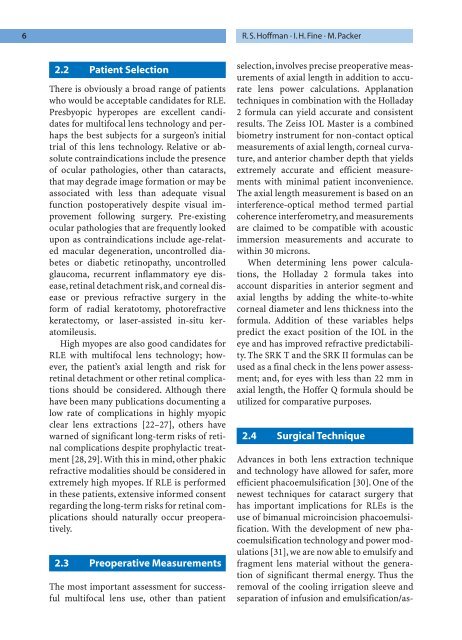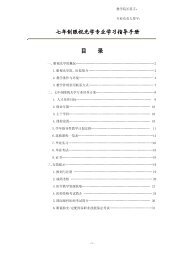Refractive Lens Surgery
Refractive Lens Surgery
Refractive Lens Surgery
You also want an ePaper? Increase the reach of your titles
YUMPU automatically turns print PDFs into web optimized ePapers that Google loves.
6 R.S. Hoffman · I.H. Fine · M. Packer<br />
2.2 Patient Selection<br />
There is obviously a broad range of patients<br />
who would be acceptable candidates for RLE.<br />
Presbyopic hyperopes are excellent candidates<br />
for multifocal lens technology and perhaps<br />
the best subjects for a surgeon’s initial<br />
trial of this lens technology. Relative or absolute<br />
contraindications include the presence<br />
of ocular pathologies, other than cataracts,<br />
that may degrade image formation or may be<br />
associated with less than adequate visual<br />
function postoperatively despite visual improvement<br />
following surgery. Pre-existing<br />
ocular pathologies that are frequently looked<br />
upon as contraindications include age-related<br />
macular degeneration, uncontrolled diabetes<br />
or diabetic retinopathy, uncontrolled<br />
glaucoma, recurrent inflammatory eye disease,retinal<br />
detachment risk,and corneal disease<br />
or previous refractive surgery in the<br />
form of radial keratotomy, photorefractive<br />
keratectomy, or laser-assisted in-situ keratomileusis.<br />
High myopes are also good candidates for<br />
RLE with multifocal lens technology; however,<br />
the patient’s axial length and risk for<br />
retinal detachment or other retinal complications<br />
should be considered. Although there<br />
have been many publications documenting a<br />
low rate of complications in highly myopic<br />
clear lens extractions [22–27], others have<br />
warned of significant long-term risks of retinal<br />
complications despite prophylactic treatment<br />
[28, 29].With this in mind, other phakic<br />
refractive modalities should be considered in<br />
extremely high myopes. If RLE is performed<br />
in these patients, extensive informed consent<br />
regarding the long-term risks for retinal complications<br />
should naturally occur preoperatively.<br />
2.3 Preoperative Measurements<br />
The most important assessment for successful<br />
multifocal lens use, other than patient<br />
selection, involves precise preoperative measurements<br />
of axial length in addition to accurate<br />
lens power calculations. Applanation<br />
techniques in combination with the Holladay<br />
2 formula can yield accurate and consistent<br />
results. The Zeiss IOL Master is a combined<br />
biometry instrument for non-contact optical<br />
measurements of axial length, corneal curvature,<br />
and anterior chamber depth that yields<br />
extremely accurate and efficient measurements<br />
with minimal patient inconvenience.<br />
The axial length measurement is based on an<br />
interference-optical method termed partial<br />
coherence interferometry, and measurements<br />
are claimed to be compatible with acoustic<br />
immersion measurements and accurate to<br />
within 30 microns.<br />
When determining lens power calculations,<br />
the Holladay 2 formula takes into<br />
account disparities in anterior segment and<br />
axial lengths by adding the white-to-white<br />
corneal diameter and lens thickness into the<br />
formula. Addition of these variables helps<br />
predict the exact position of the IOL in the<br />
eye and has improved refractive predictability.<br />
The SRK T and the SRK II formulas can be<br />
used as a final check in the lens power assessment;<br />
and, for eyes with less than 22 mm in<br />
axial length, the Hoffer Q formula should be<br />
utilized for comparative purposes.<br />
2.4 Surgical Technique<br />
Advances in both lens extraction technique<br />
and technology have allowed for safer, more<br />
efficient phacoemulsification [30]. One of the<br />
newest techniques for cataract surgery that<br />
has important implications for RLEs is the<br />
use of bimanual microincision phacoemulsification.<br />
With the development of new phacoemulsification<br />
technology and power modulations<br />
[31], we are now able to emulsify and<br />
fragment lens material without the generation<br />
of significant thermal energy. Thus the<br />
removal of the cooling irrigation sleeve and<br />
separation of infusion and emulsification/as-



